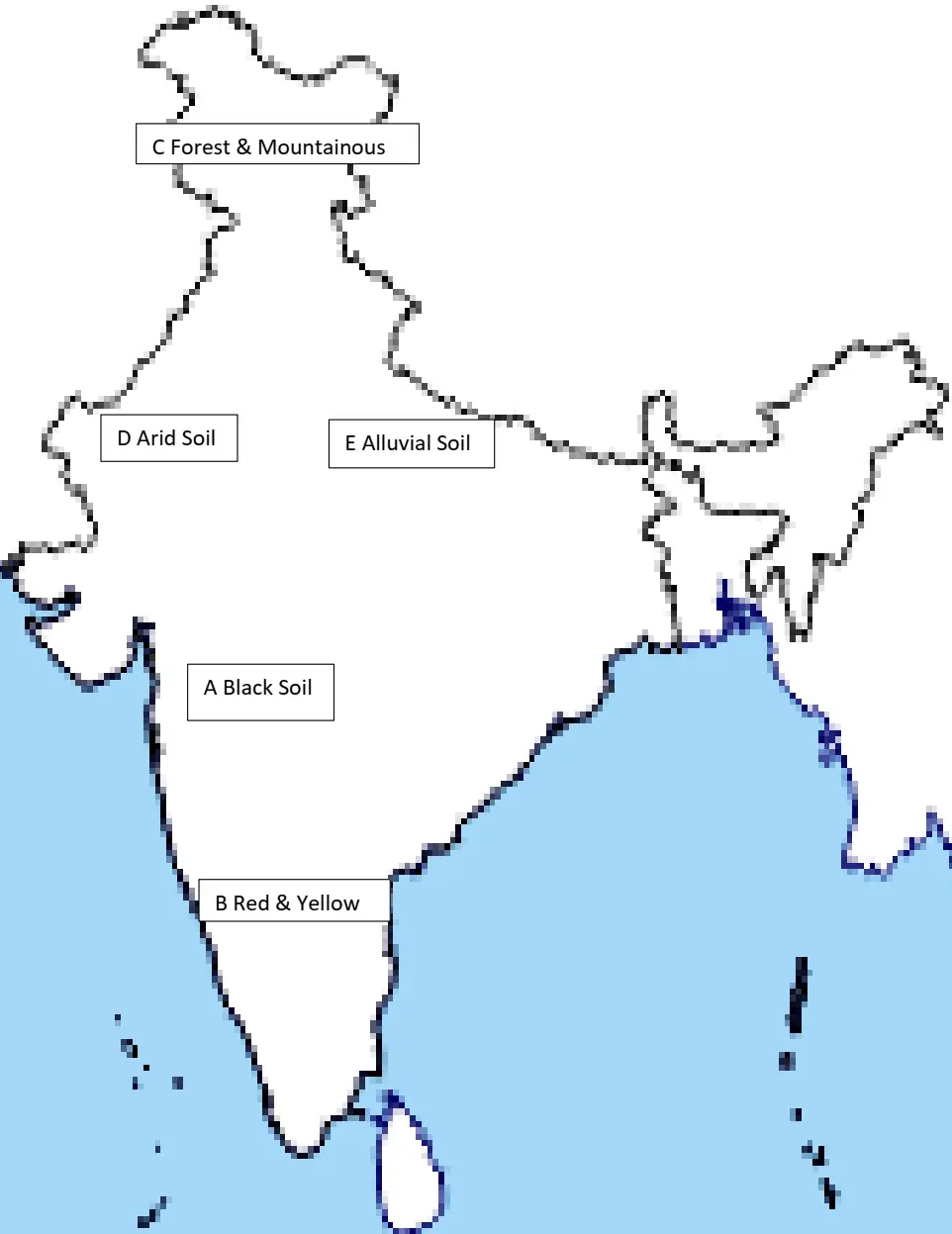Competency Based Questions for Class 10 Geography Chapter 1 Resources and Development
1 Mark Questions
Question.1 Mohan gives his friend a clue about type of land-
- The land left uncultivated for one year or less than one year
- Other than current fellow
What type of land is this?
Answer. Fellow Lands
Question.2. In June 1992 more than 100 states head met here. This was the first international summit of its kind. The leaders signed the declaration on global climatic change and biological diversity.
Identify the summit and the country where it was held.
Answer. Rio de Janerio Earth Summit, Brazil
Question.3. Radhika, an environment activist of Madhya Pradesh explained some reasons of land degradation. She stated that Deforestation, Erosion, over grazing, mining, quarrying, flood, landslides etc. are some of the prominent reasons of land degradation.
Identify the reasons which are not done by human activities.
Answer. Erosion, flood and landslides.
Question.4. Find out, which is not the way to solve the problem of land degradation-
Stabilisation of Sand Dunes, Planting of Shelter belts, Discharge of industrial effluents into the rivers, Afforestation, Control of mining activities, Control of over grazing, Deforestation.
Answer. Discharge of industrial effluents into the rivers, Deforestation
Question.5. Akash gave his friends three clues about a type of soil –
- It is found in Maharashtra, Saurashtra Malwa etc.
- is made up of lava flows.
- also known as Regur soils.
What soil is being referred to by Akash?
Answer. Black Soil
Question.6. The running water cuts through the clayey soils and makes deep channels. What is this called in the Chambal area?
Answer. Ravines
Question.7. The lower horizons of the soil are occupied by Kanker because of the increasing calcium contents downwards. The kanker layer formation restrict the infiltration of water.
What kind of soil is being referred to?
Answer. Arid Soil
Question.8. Chaman visited a field in the vacation with his grandfather. He found that
- The field slope is too steep.
- The field is partitioned into long, narrow strips.
- The strips have two different crops planted in rows.
- He observed that this style of cropping can prevent soil erosion effectively.
Can you name the type of farming?
Answer. Strip Farming
Question.9. Sima has been allotted a land of 2 Acres near a mountain with forest cover. When she observed and lab tested the soil, she found the following.
- It is humus rich but lakes plant nutrients.
- Its PH is less than 6.0
- The neighbour lands are dominated by cashew nut farming.
Identify the soil type.
Answer. Laterite Soil
Question.10. ‘Laterite’ has been derived from the Greek word ‘later’. What does the term ‘later’ mean?
Answer. Brick
Question.11. The running water cuts through clayey soil and makes deep channels. What are they called?
Answer. Gully erosion.
Question.12. Name the relief feature occupying the largest area, along with its percentage share in the total area.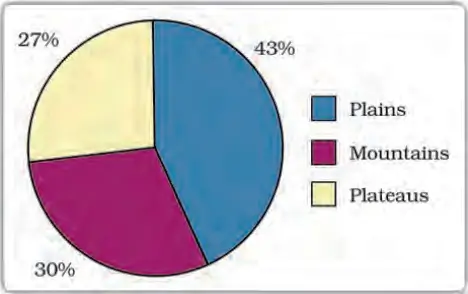
Question.13. RIO DE JANEIRO EARTH SUMMIT, 1992
In June 1992, more than 100 heads of states met in Rio de Janeiro in Brazil, for the first International Earth Summit. The Summit was convened for addressing urgent problems of environmental protection and socioeconomic development at the global level. The assembled leaders signed the Declaration on Global Climatic Change and Biological Diversity. The Rio Convention endorsed the global Forest Principles and adopted Agenda 21 for achieving Sustainable Development in the 21st century.
What did the assembled leaders signed?
Answer. Declaration on Global Climatic Change and Biological Diversity.
Question.14. Mohan’s land was over irrigated due to negligence. Water logging has increased salinity & alkalinity in the soil.
What will happen to Mohan’s land due to over irrigation?
Answer. Mohan’s land will degrade (Land degradation)
Question.15. India is the one of the fastest growing populations and economies, there is an increasing demand for electricity and energy.
There are lot of many benefits of developing renewable energy resources. Moreover, solar energy is clean as long as there is sunshine, energy can be harnessed and deployed anywhere.
Which states has great potential for solar energy?
Answer. Rajasthan
Question.16. During the summer break, Avantika went to her village for the first time. While exploring her grandfather’s fields, she noticed a few pieces of land were left uncultivated. When asked she was told that this land comes under culturable wasteland in which a piece of land is left uncultivated for more than ___ agricultural years to improve land’s quality.
Answer. More than 5 agricultural years
Question.17. Srishti has drawn a figure in which she has shown interaction between nature, technology and institutions to accelerate economic development.
Answer. Process of transformation
Question.18. While making a project, Nimisha has mentioned the following solution to reduce ____________ in industrial and suburban areas?
- Proper management of wasteland.
- Control of mining activities.
Proper discharge and disposable of industrial effluents and waste.
Answer. Land degradation
Question.19. In a group study between Aditi, Pratistha and Jyoti. The girls were giving input about a soil as-
- It is fertile soil.
- Due to its high fertility, the region is intensively cultivated and densely populated.
- It has the properties of sand, silt and clay.
- It is the most important and widely spread soil.
What soil are they discussing about?
Answer. Alluvial Soil
Question.20. Manjeet could not categorize resources with their examples/typesResource on the basis of exhaustibility
Resource Example
- __________ Solar & Wind Energy
- __________ Minerals & Fossil Fuel
Answer.
- Renewable Resources
- Non-Renewable Resources
Multiple Choice Questions (MCQs)
Question.1. Look at this news clip
Do you think this start-up will make a profitable business in India?
(a) Yes, because the source, human waste is technologically accessible & economically feasible in India
(b) Yes, because the Indian population ranks no.1 in the world & the start-up can get abundant raw materials
(c) No, because majority of Indian society culturally do not accept human waste as a source of energy.
(d) None of the above.
Answer
(c) No, because majority of Indian society culturally do not accept human waste as a source of energy.
Question.2. Look at this data.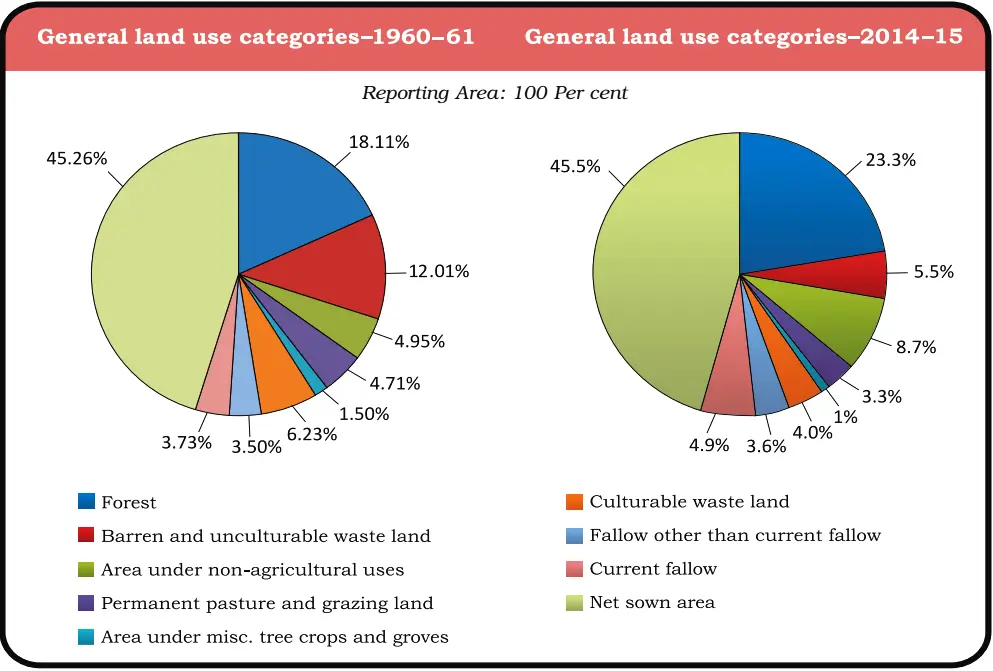
What might be the reasons behind food sufficiency in India? You can choose multiple answers.
(a) Import of huge amount of crops from other countries
(b) Increase in production of crops like Millets which grow easily in low rainfall & soil fertility
(c) Use of modern farming & chemical fertilisers
(d) By conserving Indigenous variety crop seeds
Answer
(c) Use of modern farming & chemical fertilisers
Question.3. Observe this picture.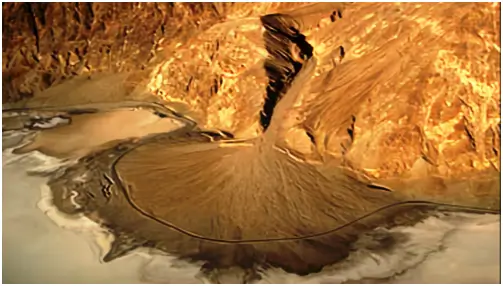
Write the name this landform? Choose the correct one.
(a) George
(b) Delta
(c) Alluvial Fan
(d) None of the above
Answer
(c) Alluvial Fan
Question.4. The inequitable distribution of access to resources has disrupted the world peace by dividing the society into ________.
(a) The haves and the don’t haves
(b) The environmentalists and exploiters
(c) The climate change believers & climate change deniers
(d) Resource rich regions and resource poor regions.
Answer
(a) The haves and the don’t haves
Question.5. The colonial powers looted India’s rich resources to gain supremacy. Why was India not able to resist the exploitation of these resources?
(a) Due to lack of use for products derived from natural resources
(b) Due to the colonising countries superior technologies.
(c) Due to lack of awareness about India’s resources.
(d) Due to over-utilisation of resources.
Answer
(b) Due to the colonising countries superior technologies.
Question.6. Most of the alluvial soil found in India is formed from the silt deposited by the Indo-Gangetic-Brahmaputra rivers. Which of the following regions contains the parent rock that forms this silt?
(a) Himalayas
(b) Gangetic Delta
(c) Northern plains
(d) Eastern coastal plans
Answer
(a) Himalayas
Question.7. In which five-year plan India made concentrated effort for achieving the goal of resource planning?
(a) First
(b) second
(c) seventh
(d) Fifth
Answer
(a) First
Question.8. All the minerals, water resources, forests, wildlife, land within the political boundaries and oceanic area upto (22.2 km) from the coast termed as territorial water and resources therein belong to the nation.
(a) 12 nautical miles
(b) 22.2 km
(c) both (a) and (b)
(d) 12 Km
Answer
(a) 12 nautical miles
Question.9. Everything in our environment which satisfy our needs, Technologically accessible, economically feasible and and culturally acceptable is called as …………
(a) institutions
(b) Technology
(c) nature
(d) resource
Answer
(d) resource
Question.10. Which one of the following is not an example of renewable resources?
(a) Solar energy
(b) wind energy
(c) water energy
(d) minerals
Answer
(d) minerals
Question.11. Resources which are surveyed and their quantity and quality have been determined for utilisation are known as:-
(a) potential resources
(b) stock
(c) development resources
(d) Reserves
Answer
(c) development resources
Question.12. Which of the following soil is known as regur soil?
(a) black soil
(b) red soil
(c) laterite soil
(d) arid soil
Answer
(a) black soil
Question.13. Land degradation in Punjab is mainly due to
(a) excessive cultivation
(b) overgrazing
(c) over-irrigation
(d) deforestation
Answer
(c) over-irrigation
Question.14. Which one of the following states has mostly laterite soil?
(a) Uttar Pradesh
(b) Bihar
(c) Rajasthan
(d) Karnataka
Answer
(d) Karnataka
Question.15. While reading an article on ‘Resources.’ Ankush had highlighted various statements about resources. The highlighted statements are-
(a) Resources are free gifts of nature.
(b) They are the functions of human activities.
(c) Resources are technologically accessible.
(d) It is vital for human survival.
Which one of the statements is incorrect about the term ‘resources?
Answer
(a) Resources are free gifts of nature.
Question.16. In a class test, a teacher asked Anchal to classify resources ‘On the basis of origin’ for which she answered: –
(i) Abiotic resources are obtained from the biosphere and have life, such as human beings, flora & fauna.
(ii) Biotic resources are all those things which are composed of non-living things, like rocks and metals.
Identify the correct statement.
(a) Both (i) and (ii) are true.
(b) Both (i) and (ii) are false.
(c) Option (i) is correct but (ii) is incorrect.
(d) Option (i) is incorrect (ii) is correct.
Answer
(b) Both (i) and (ii) are false.
2 Mark Questions
Question.1. Imagine, if oil supply gets exhausted one day, how would it affect our lifestyle?
Answer. If oil supply gets exhausted one day, all machines and motors run on oil will stop at once and life will be affected badly. The transportation system including Rail, Bus, Aeroplane, Ship etc will not be able to move. Many industries also will stop running and producing goods.
Question.2. Suggest at least two measures for maintaining sustainable development.
Answer.
- Use of renewable energy in place of conventional energy source. e.g. Solar energy, Wind energy, Tidal energy etc.
- Judicious use of Conventional energy so that it can be prolonged and the nature will get time to replenish them.
Question.3. “There is enough for everybody’s need and not for any body’s greed” Give your views in support of the statement.
Answer. Need can be fulfilled but greed cannot be fulfilled. In order to fulfil the greed people start producing more than their need that will lead to mass production, resulting irrational consumption and over utilisation of resources.
Question.4. Schumacher in his book “Small is Beautiful” has stated that, minimising the use of resources in our daily life, we can contribute to a greener & safer earth. Write any two ways in which you can minimise use of resource in your daily life.
Answer. Any two ways in which we can minimise use of resource in our daily life are:-
- Using public transport system, we can save fuel.
- Recycle More and Improve Recycling Systems.
Question.5. If the oil supply gets exhausted one day, how would this affect our life style?
Answer. If the oil supply gets exhausted one day, this would affect our life in the following :-
- The machines, vehicles, railways, etc., wouldn’t run and thus, people would not be able to travel from one place to another.
- As most of our activities depend on petroleum products completely exhausting it can confine people to smaller places like the ancient times.
(Any other relevant points)
Question.6. Severe land degradation factors for Punjab & Odisha are not the same? How?
Answer. Severe land degradation factors for Punjab & Odisha are not the same because :-
- In Odisha mining and quarrying severely damaged lands and in Punjab the land degraded due to over irrigation & chemical fertilisers.
- Punjab has alluvial plain with vast agricultural activities but Odisha has huge deposits of minerals and less plain area.
Question.7. “India has enormous diversity in the availability of resources.” Name four varied regions to justify this statement.
Answer. There are regions which are rich or self-sufficient in certain types of resources and there are areas that are deficient or have acute shortage of some vital resources. For example: The states of Jharkhand, Chhattisgarh and Madhya Pradesh are rich in minerals and coal deposits. Arunachal Pradesh has abundance of water resources but lacks in infrastructure development. Rajasthan is very well endowed with solar and wind energy but lacks in water resources. The cold desert area of Ladakh has very rich cultural heritage. It is deficient in water, infrastructure and some vital minerals.
Question.8. “Soil is the most important renewable natural resource”. Explain.
Answer. Soil is the most important renewable natural resource because it is the medium of plant growth and supports different types of living organisms on earth. It serves as a medium for plant growth and sustains various earth’s life forms. It is a biological system, the soil. Up to a few centimetres deep, soil formation takes millions of years. Soil development is influenced by several elements, including relief, parent rock or bedrock, climate, and flora. The creation of soil is influenced by some natural forces, including temperature changes, the flow of water, wind, and glaciers, as well as the activity of decomposers.
Question.9. “Agenda 21”
It is the declaration signed by world leaders in 1992 at the United Nation’s Conference on Environment and Development (UNCED). Give two major objectives of Agenda 21.
Answer.
- It aims at achieving global sustainable development.
- Every local government should draw its own local Agenda 21.
Question.10. Suggest any two ways in which resources could be used judiciously.
Answer.
- Conservation of resources
- Planning of resources
Question.11. “The future generation may not have sufficient resources as compared to present generation.” Justify the statement with two relevant reasons.
Answer. Future generations may not have sufficient resources as compared to the present generation because :-
- Overuse of land resources is causing land degradation.
- Overuse of fossil fuels by present generation like coal, petroleum, etc. have limited supply and may get depleted.
Question.12. Suggest any two steps that can be taken to solve the problem of land degradation.
Answer. The methods to solve the problem of land degradation are :-
- Afforestation over deforested areas.
- Proper management of grazing to control over grazing.
Question.13. How is Bangar different from Khadar?
Answer. Bangar soil:
- it is an old Alluvial soil.
- it is less fertile.
Khadar soil:
- It is a new Alluvial soil.
- it is more fertile.
Question.14. What do you mean by waste land and land put to other non-agricultural uses?
Answer.
- waste land include Rocky, arid and desert regions .
- land put to non- agricultural uses includes settlements, roads, Railways, industry etc.
Question.15. Which nutritive elements are found in black soil?
Answer.
- calcium carbonate
- magnesium
- Potash
- lime
3 Mark Questions
Question.1. “Resources are a function of human activities”. Elaborate the statement with suitable arguments.
Answer.
- Natural resources are the free gifts of nature but many man made resources are used by the humanity.
- Resources are functions of human activities. Human beings themselves are essential components of resources.
- They transform material available in our environment into resources and use them.
Question.2. List the problems caused due to the indiscriminate use of resources by human being?
Answer.
- Depletion of resources for satisfying the greed of few individuals.
- Accumulation of resources in few hands, which, in turn, divide the society into two, segments i.e. ‘haves’ and ‘have nots’ or rich and poor.
- Indiscriminate exploitation of resources has led to global ecological crises such as, global warming, ozone layer depletion, environmental pollution and land degradation
Question.3. How did Agenda 21 help ensure sustainable development?
Answer.
- Agenda 21 focuses on attaining Global Sustainable Development.
- It’s main aim is to fight the environmental damage, poverty, diseases through global cooperation on common interest, mutual needs and shared responsibilities.
- An important and distinct aim of the agenda is that every local government should draw its own local Agenda 21.
Question.4. Explain how equitable distribution of resources will lead to sustained quality of life & world peace?
Answer. Equitable distribution of resources will lead to sustained quality of life & world peace in the following ways :-
- Equitable distribution of resources will lead to preserve all forms of life, thus by increasing resource availability.
- It will check the exploitation of resources by few individuals and will reduce the chances of conflict or war.
- With proper resource management every individual including the future generation will have resource availability.
Question.5. A balanced resource planning at the national, state, regional and local levels is required for equitable resource development. Explain the roles of these three levels to develop a hydroelectric power plant in a river valley.
Answer. A balanced resource planning at the national, state, regional and local levels is required for equitable resource development. The roles of these three levels to develop a hydroelectric power plant in a river valley can be defined as-
- At the local level the affected people by the hydroelectric power plant should be consulted and should be convinced of its benefits and ensure proper compensation and rehabilitation by administration.
- At the state level the proper management & institutional set up should be done.
- At the national level the objective of the project should be realised by equitable developmental goals.
Question.6. Suggest any three ways to combat future energy needs of India.
Answer. Any three ways to combat future energy needs of India :-
- Renewable energy resources like solar, wind etc. should be given priority in research and development.
- Population control majors to be adopted for minimising per capita energy & resource consumption.
- Reusing, recycling and awareness on energy efficiency and conservation.
Question.7. Write some measures/ways to solve problems of land degradation.
Answer.
- Afforestation.
- Proper management of grazing to control over grazing.
- Planting of shelter belts of plants.
- Stabilization of sand dunes by growing thorny bushes.
- Control of mining activities.
Question.8. Resources are a function of human activities? Justify.
Answer. Mere presence of resources, as free gifts of nature, does not make them resources. Human beings are essential components of resources because they transform material available in our environment into resources. The utility of resources depends on the stage of cultural development of man and the tools and technology used by him.
Question.9. “Planning is the widely accepted strategy for judicious use of resources in a country like India”.
Justify this statement with three relevant points.
Answer. Resource planning is a term that is used to refer to the strategy for planned and careful utilisation of resources.
Resource planning is essential for the sustainable survival of all life forms. This shows that resource planning is required at the national, regional, state and local levels for the steady improvement of a country. Resource planning is essential because of the following reasons:
- It helps to recognise the various resources existing in different areas of the country.
- It aids in the preservation of different non-renewable resources.
- It reduces the wastage of resources.
Question.10. “The earth has enough resources to meet the needs of all but not enough to satisfy the greed of even one person.” Give your views in support of the statement.
Answer. This statement is relevant to the discussion of development since both resources and development go hand in hand.
- Earth has enough resources for every need and those resources must be used judiciously.
- Over exploitation of resources will lead to environmental degradation and eventually affect the current generation and the future generations.
- The development should be sustainable in nature and not exhaustive and over exploitative.
Question.11. While preparing a project on soil conservation. Atul has collected various pictures of fields.
(a) 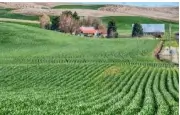


Answer.
- Contour Ploughing: Ploughing along the contour lines can check the flow of water down the slopes. It is called contour ploughing. It can be practiced on hills.
- Terrace Cultivation: Steps can be cut out on the slopes making terraces. It restricts soil erosion. It is practiced in western and central Himalayas.
- Strip Farming: Large fields can be divided into strips. Strips of grass are left to grow between the crops. This breaks up the force of wind. The method is called strip farming.
Question.12. Give explanation of how mining activities are responsible for environmental degradation.
Answer. Mining activities are responsible for environmental degradation in the following ways :-
- The mineral processing like grinding of limestone for cement industries and calcite and soap stone for ceramic industries, generate huge quantity of dust in atmosphere.
- This dust settles down on the land and retards infiltration of water into soil.
- Industrial effluents are polluting land and water tremendously.
Question.13. Explain any three steps taken to solve the problem of Land Degradation in India.
Answer.
- Afforestation: afforestation and proper management of grazing can help to some extent.
- Planting: planting of shelter belts, control on overgrazing, stabilization of sand dunes by growing thorny bushes.
- Control ploughing: contour plogging is another step to conserve land. The fields are ploughed, harrowed, and sown along the natural contour of The Hills.
Question.14. “Land is a natural resource of utmost importance.” Justify the statement with the appropriate arguments.
Answer.
- we live on land; we perform our economic activities on land and we use it in different ways.
- It supports natural vegetation, wildlife, human life, economic activities, transport and communication systems.
- it is an asset of a finite magnitude.
Question.15. What does the term “Sustainable economic development mean? How can we eradicate irrational consumption and over utilisation of resources?
Answer.
- Sustainable economic development means development should take place without damaging the environment and development in the present should not compromise with the needs of the future generations.
- We can eradicate irrational consumption and over-utilisation of resources through conservation of resources. Irrational consumption and over -exploitation of resources lead to many socioeconomic and environmental problems to overcome these problems and to preserve resources for our future generation as well,proper management and conservation of resources is essential.
5 Mark Questions
Question.1. ‘Indiscriminate use of resources had led to numerous problems.’Justify this statement.
Answer. Resources are vital for human survival and it is believed that resources are free gift of nature.
The end indiscriminate use of resources has led to the following problem :-
- To satisfy the greed of few individuals, depletion of resources has continued.
- due to the accumulation of resources in few hands the society gets divided into two segments, that is rich and poor.
- Indiscriminate use of resources has led to ecological crisis, examples ozone layer depletion.
- Land Degradation.
- global warming and environment pollution.
Question.2. What steps can be taken to control soil erosion in hilly areas?
Answer. Method of soil conservation :-
- Contour ploughing or ploughing along the contour lines of Highland can decelerate the flow of water down the slopes.
- Terrace cultivation or cutting of steps around the slopes to provide land for agriculture also checks Downhill flow of water and controls erosion ,example as in western and Central Himalayan region.
- Strip cropping:- large fields can be divided into strips. Strips of grass are left to grow between the crops. This breaks up the force of the wind.
- Afforestation or planting of trees in the Hilly regions can help in soil conservation.
- Scientific development work should be implemented.
Question.3. Why is resource planning essential in India?
Answer. Resource planning is a technique or skill for proper utilisation of resources :-
- As resources are limited, their planning is necessary so that we can use them properly and also save them for our future generations.
- Resources are not only limited, but they are distributed over different parts of the country.
- Resource planning is also essential for production of resources and to protect them from over exploitation.
- By the resource planning we can overcome on problems.
- Resource planning is very necessary for Judicious use of resources.
Question.4. “Soil formation is a continuous process”, Agree with this statement in detail.
Answer. Relief features, parent material, atmosphere, vegetation and other types of life, as well as time away from human activities, are the key factors responsible for soil formation.
- Parent Material:- is deposited by streams or is derived from in-situ weathering. At this point, soil has many properties, such as mineral composition, colour, particle size and chemical elements. Black soil, for example, derives its colour from lava rock.
- Climate:- This is one of the key factors in soil formation because it influences the weathering rate of the parent rock.
- Function of precipitation:- The variability of precipitation affects the composition of the soil. For example, areas with low rainfall and high evaporation rates have led to the accumulation of salts in the soil. The soils underlying tropical rainforests appear to be nutrient-poor due to extensive leaching due to heavy rainfall.
- Function of temperature:- It also plays an important role because temperature variations cause shrinkage and swelling, frost action and general soil weathering.
- Biota (Flora, Fauna and Microorganisms):- Biota, in combination with climate change, modifies the parent material for the production of soil. For example, leguminous plants (such as beans, peas and groundnuts) have nitrogen-fixing bacteria.
- Topography (Relief, Altitude, and Slope):- It is considered a passive factor in climate change because it influences soil processes, soil distribution and the form of vegetation.
- Time:- The formation of the soil is not a one-day process, but takes several years of formation. Younger soils have similar characteristics from their parent material, but as they mature, the addition of organic matter, exposure to moisture and other environmental factors can change their characteristics.
Question.5. Indiscriminate use of natural resources has led to numerous problems.” Justify the statement.
Answer. Indiscriminate use of natural resources has led to numerous problems. The following points justify the statement.
- Human activities, like cutting and felling of trees, and lopping of trees, have led to destruction of forests. Such losses have increasingly marginalised and impoverished many communities, who depend upon forests for food medicine, etc.
- Some human activities, such as deforestation, overgrazing, mining and quarrying, have contributed to land degradation.
- Water resources have been polluted by domestic and industrial wastes, chemicals, pesticides and fertilizers used in agriculture, thus making it unfit for human and as well as animals’ consumption.
Question.6. Two places A, B, C, D and E have been marked on the given outline map of India Identify them and write their correct names of the soil on the lines drawn near them.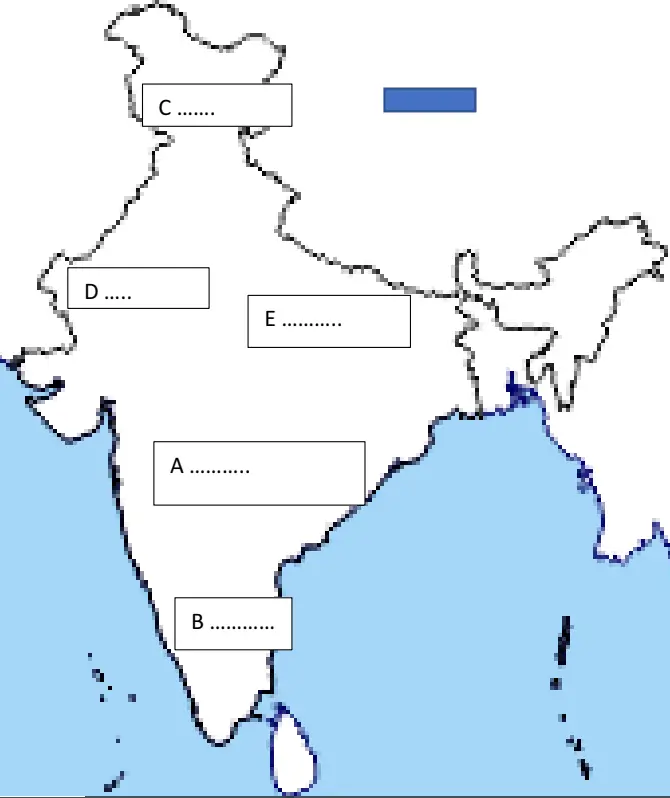
A Black Soil
C Forest & Mountainous
D Arid Soil E Alluvial Soil
B Red & Yellow
Question.7. How do technical and economic developments led to more consumption of resources?
Answer. These days, technical and economic developments gain a colossus space. The government is also focusing more on technical and economic growth to make our county a fully developed country. In this process of technical and economic growth, the resources of our country are exhausting rapidly. Technological and economic developments have led to such rapid consumption of resources because of the following reasons:
- New and improved equipment are introduced with the development of technology, which ultimately lead to an increase in the use of natural resources.
- The technological advancement is attributed to the growth of a developing country. People of an economically developing nation consume more resources. Hence, we can safely say that an improvement in economic development of a nation will directly result in the increase of its people’s consumption of resources.
- Development of new technologies is widely seen in developing economies. Due to economic development, the bright minds get an opportunity to experiment with their ideas. As a matter of fact, various materials are converted in to useful resources. This creates an atmosphere, which will see a steady increase in consumption of such available resources.
Question.8. Why is resource planning essential in India?
Answer. Resource planning is a procedure of proper utilisation of resources. Resource planning is important because:
- Resources in India are not evenly distributed. Some parts of the county are rich in one resource but deficient in other important resources which are essential. For example, Rajasthan is rich in solar and wind energy but lacks water resource. Jharkhand is rich in minerals and coal deposits but lack in industrialisation. This is the reason why resource planning is essential. An effective resource planning will help in effective use of the resources available in the environment.
- Secondly, most of the resources present in our environment are limited. Therefore, if these resources are not preserved or not used rationally we will be in great trouble. For example: Petrol is a limited resource and it cannot be renewed. Exhaustion of petrol will create huge chaos in the country as we are extensively dependent on the petrol.
- Thirdly, resource planning is important because it minimises the wastage or over utilisation of resources. The very first step of resource planning is to make a list of resources available in the environment. This helps us to assess which resources should be used and how much it should be used to prevent over utilisation and minimise wastage.
Question.9. Mention any five daily life practices people can adopt to minimise water resource consumption.
Answer. Any five daily life practices from student’s daily life experiences.
Question.10. Give some measures on how can we conserve resources.
Answer. Using water judiciously via using less water during day-to-day activities.
- Turn off lights when not in use.
- Promoting the use of renewable energy.
- Implementing the principle of 3 R’s (Reduce, Recycle, Reuse).
- Promoting the use of organic compost.
Question.11. Look at the picture and explain the land-use pattern in India.
- Net sown area, where regular agriculture is done — 43.41%.
- Forests, 22.57% of the total land is covered by forests.
- Barren and waste land — 6.29%.
- Area under non-agricultural use — 7.92%.
- Permanent pastures and grazing land — 3.45%.
- Area under miscellaneous tree crops and groves — 1.1%.
- Culturable waste land — 4.41 %
- Fallows other than current fallows — 3.82%
- Current fallow – 7.03%
- The land under forests has increased marginally by about 4.46%. From 18.11% in 1960-61, it is still only 22.57% which is far lower than the desired 33% as outlined by the National Forest Policy (1952).
Question.12. Imagine if oil supplies gets exhausted, how will this affect our life style?
Answer. If oil supplies get exhausted, this will affect our lifestyle very much. In this situation machines, vehicles and railways, etc all are not working. The majority of the country’s transportation is basedon fossil fuels. It would be hampered as well. Also, for individuals who create electricity through
generators, it would be more difficult to generate electricity because oil is required to do so.
Question.13. Prioritize the issue of sustainability for the development of resources with example.
Answer. Sustainable Development means development that takes place without damaging the environment or compromising the ability of the future generations to meet their own needs.
- The resources are not free gifts of nature. Their exploitation will lead to their depletion and thus halt development. E.g., resources like petroleum are exhaustible resources, their reckless exploitation will lead to their deficiency.
- Resources are vital for development. Industries, agriculture, etc. all depend on resources. Economic development depends on resource availability.
- Millions of people earn their livelihood and sustain resources. Resources like minerals and coal are pre-requisite for development. Water, food, etc. are necessary for survival. To protect future generations.
Hence, we need to use the resources judiciously to sustain development.
Question.14. “India is rich in certain types of resources but deficient in some other resources.” Support your answer with appropriate example.
Answer. India has great diversity of resource. Thus, there is a need to make proper use and planning of resource in India:-
- Rich deposits of coal and minerals are available in the states of Jharkhand, Chhattisgarh and Madhya Pradesh.
- An abundance of water resources is available from the state of Arunachal Pradesh but there is lack of infrastructure for its development.
- The state of Rajasthan is endowed with solar and wind energy but lacks infrastructural development.
- The cold desert of Ladakh has a rich cultural heritage but lacks water infrastructure and vital minerals. This place is isolated from rest of the country.
Question.15. • On the given outline map of India featured alphabets as A, B, C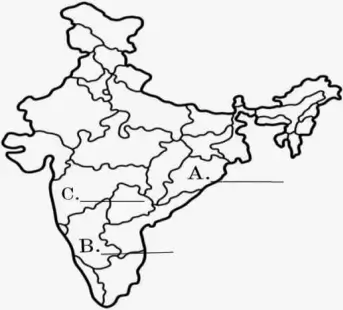
- On the same outline map of India, locate & label states accordingly-
(a) an area having potential of solar energy.
(b) an area suffering from land degradation due to over irrigation.
Answer.
A. Odisha- Red Yellow Soil
B. Karnataka- Laterite Soil
C. Maharashtra- Black Soil
(a) Gujarat/Rajasthan
(b) Punjab/Haryana/Western UP

